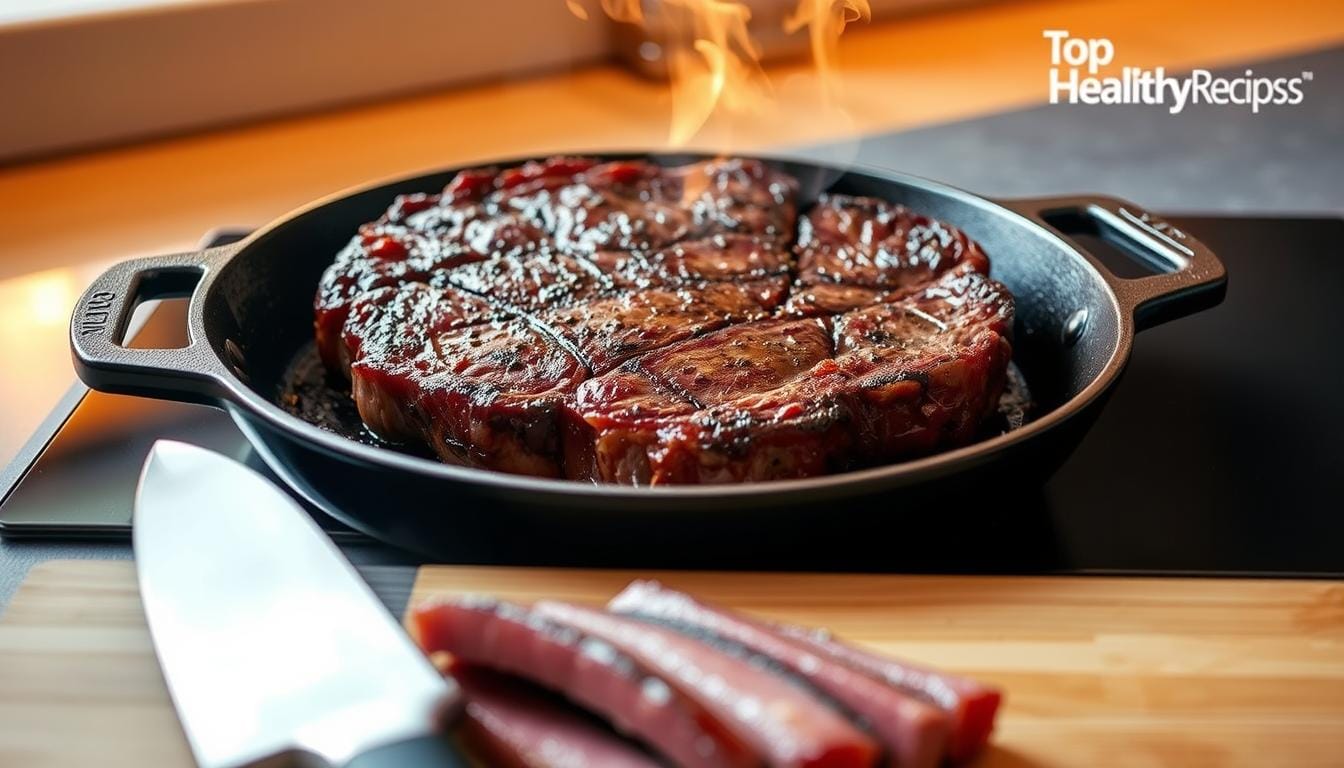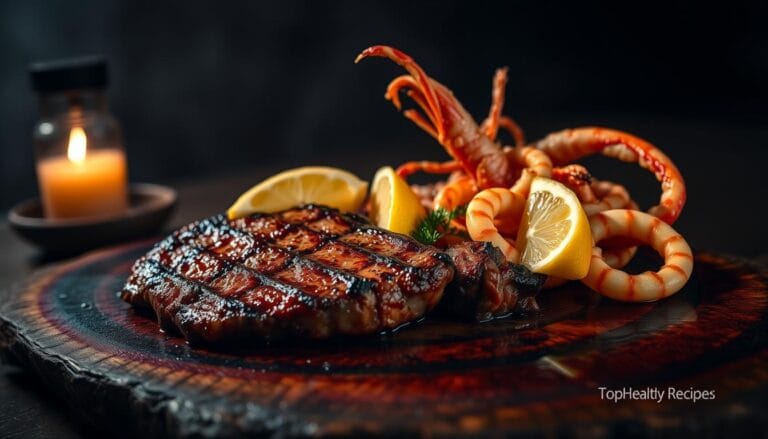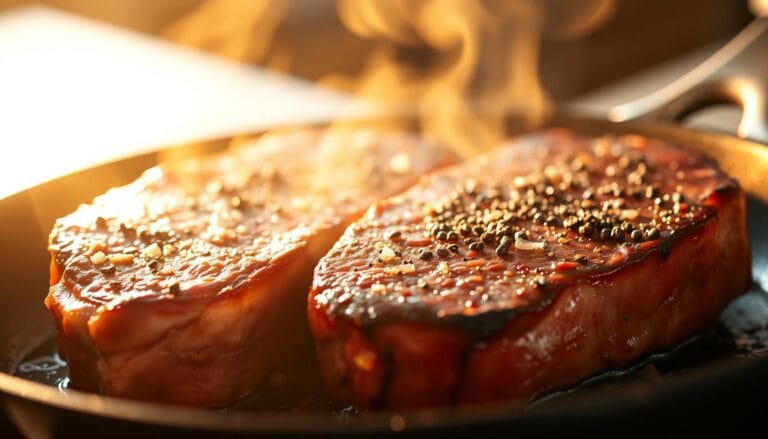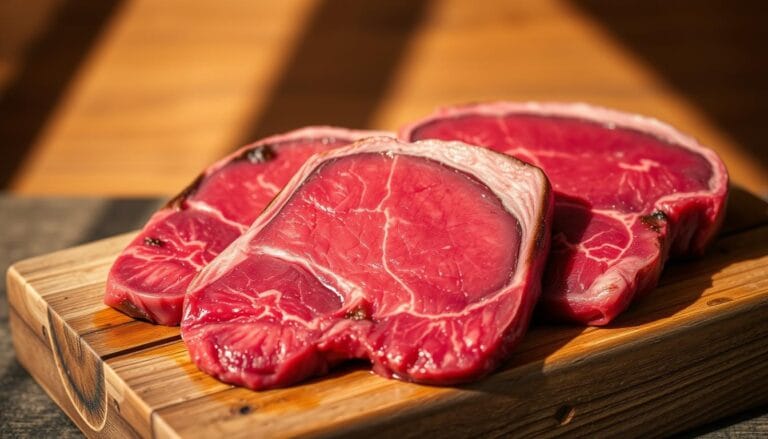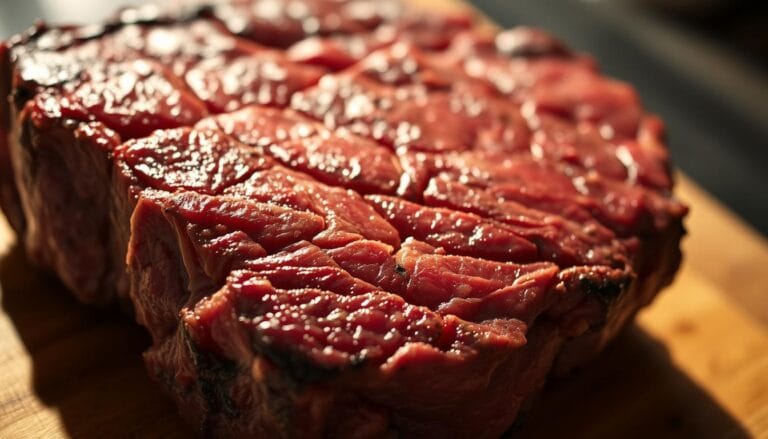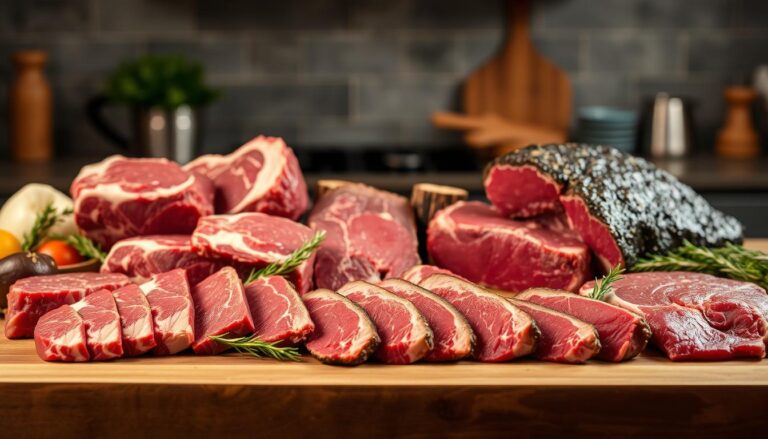How Do You Cook Skirt Steak? Quick Tips for Juicy, Tender Perfection
Table of Contents
How Do You Cook Skirt Steak? Quick Tips for Juicy, Tender Perfection
There’s something special about a perfectly cooked skirt steak. The way it melts in your mouth is amazing. Whether it’s for a weeknight dinner or a special occasion, getting it right can make a big difference. For many, cooking skirt steak seems daunting.
But with the right techniques, you can make this flavorful cut into a restaurant-quality dish. The secret is choosing the right cut, preparing it well, and cooking it just right. In this guide, we’ll show you how to master cooking skirt steak.
Key Takeaways
- Choose the right cut of skirt steak for your recipe.
- Properly prepare your skirt steak for cooking.
- Master various cooking methods for skirt steak.
- Learn serving suggestions to elevate your dish.
- Avoid common mistakes that lead to toughness.
Understanding Skirt Steak and Its Cuts
Steak comes in many types, but skirt steak is special. It has a unique taste and is used in many dishes. Knowing what skirt steak is and its types is key.
What is Skirt Steak?
Skirt steak comes from the cow’s diaphragm muscle. It’s known for its strong taste and texture. This makes it great for certain cooking ways.
“Skirt steak is one of the most flavorful cuts you can grill or pan-fry,” says a famous chef. Many chefs agree that it brings bold flavors when cooked right.
Different Types of Skirt Steak
There are two main types: inside and outside skirt steak. The inside cut is softer and more even. The outside cut has a stronger taste but needs careful cooking.
- Inside Skirt Steak: More tender and uniform, ideal for those seeking a slightly easier cooking experience.
- Outside Skirt Steak: More flavorful, but may require additional preparation steps to achieve tenderness.
Why Choose Skirt Steak?
Skirt steak is loved for its rich, beefy flavor and good price. It’s used in many dishes, from Mexican fajitas to Asian stir-fries. Its texture also makes it great at soaking up marinades.
The benefits of choosing skirt steak include:
- Rich flavor that stands out in various dishes.
- Affordability compared to other premium steak cuts.
- Versatility in cooking methods and cuisines.
Preparing Skirt Steak for Cooking
The secret to a tasty skirt steak is in the prep work, not just the cooking. Getting it ready right is key to making it tender and full of flavor.
First off, if your skirt steak is frozen, you need to thaw it. The best ways are thawing in the fridge, which takes about 24 hours, or cold water immersion, which can do it in 1-2 hours. Never thaw it at room temperature to avoid bacterial growth.
Thawing Frozen Skirt Steak
Thawing your skirt steak is the first step. Refrigerator thawing is easy, just put the steak in a leak-proof bag on the middle or bottom shelf. For a quicker thaw, submerge it in cold water and change the water every 30 minutes to thaw it in a couple of hours.
Trimming Excess Fat
After thawing, check your skirt steak for too much fat. Some fat is good for flavor and juiciness, but too much is bad. Trim off any excess fat, but don’t take too much off, or the steak might dry out. You want to find a good balance.
Trimming Tips: Use a sharp knife for clean cuts, and always cut away from your body. Removing excess fat improves the steak’s texture and helps it cook evenly.
Marinating vs. Dry Rubs
Choosing between marinating and dry rubs depends on what you like and what you want the steak to feel like. Marinating involves soaking the steak in a mix that tenderizes it and adds flavor.
Dry rubs, on the other hand, give the steak a flavorful crust but don’t tenderize it as well as marinades. A simple dry rub can be just salt, pepper, and herbs and spices.
| Preparation Method | Description | Benefits |
|---|---|---|
| Marinating | Soaking in a mixture of acidic and oil-based components | Tenderizes the steak, enhances flavor |
| Dry Rubs | Applying a dry mixture of spices and herbs | Creates a flavorful crust, easy to apply |
Chef Anthony Bourdain said, “Your body is not a temple, it’s an amusement park. Enjoy yourself.” When prepping skirt steak, try different marinades and dry rubs to find your favorite flavor.
Before cooking, let your steak come to room temperature for even cooking. Pat it dry with paper towels to get a better sear.
Essential Cooking Techniques for Skirt Steak
To get a tender and juicy skirt steak, knowing the right cooking methods is key. Skirt steak is a versatile cut that can be cooked in several ways, each bringing a unique flavor. We’ll look at grilling, pan-searing, and broiling as the top methods for cooking skirt steak to perfection.
Grilling Skirt Steak
Grilling skirt steak is popular because it adds a smoky taste and a nice char. First, heat your grill to 500-600°F. Oil the grates to stop the steak from sticking. Then, place the steak on the grill and cook for 2-4 minutes on each side, depending on its thickness and your desired doneness. Use the finger test or a thermometer to check if it’s done.
Pan-Seering Skirt Steak
Pan-searing is a great way to cook skirt steak, perfect when you can’t grill. To pan-sear, heat a cast-iron or heavy-bottomed skillet until it’s very hot. Add a bit of oil that can handle high heat, then put the steak in it. Cook for 2-4 minutes on each side, based on the steak’s thickness. This method helps you get a perfect crust on the outside while keeping the inside juicy.
Broiling Skirt Steak
Broiling is a good indoor option instead of grilling. To broil, place the rack 4-6 inches from the heat. Cook the steak for the same time as grilling, usually 2-4 minutes on each side. Broiling lets you get a similar char and flavor to grilling without needing an outdoor grill.
No matter the method, skirt steak cooks fast because it’s thin. It’s important not to overcook it to keep it tender. Always check the internal temperature with a thermometer to make sure it’s cooked just right.
Recommended Cooking Temperatures
The secret to a great skirt steak is knowing its perfect internal temperature. Cooking it to the right temperature makes it tender and safe. The internal temperature is key because it affects the steak’s texture and juiciness.
Understanding Doneness Levels
Skirt steak can be cooked to different levels of doneness. Each level has a specific internal temperature. For a rare steak, aim for 125°F. Medium-rare is 130-135°F, and medium is 140-145°F.
Cooking it beyond medium, above 145°F, can make it tough. This is because of the muscle structure in skirt steak.
Using a Meat Thermometer
To check the internal temperature of your skirt steak, use a digital meat thermometer. Stick the thermometer into the thickest part of the steak, avoiding bone or fat. Remember to remove the steak from heat when it’s 5°F below your target temperature.
For more cooking tips and recipes, check out shrimp on steak. It’s a great match for skirt steak.
Resting Period for Skirt Steak
After cooking, let your skirt steak rest for 5-10 minutes. This step is important for keeping the meat juicy. It allows the juices to spread evenly, preventing moisture loss.
Skirt steak’s uneven thickness can make it hard to cook evenly. But, with a thermometer and following these guidelines, you can get it just right.
| Doneness Level | Internal Temperature (°F) |
|---|---|
| Rare | 125 |
| Medium-Rare | 130-135 |
| Medium | 140-145 |
Flavoring Options for Skirt Steak
To make your skirt steak stand out, try different flavorings. Skirt steak’s rich taste can be boosted with the right marinades, seasonings, and sides. This makes it a standout dish.
Marinades to Enhance Flavor
Marinades are key for adding flavor to skirt steak. They tenderize the meat and infuse it with flavors. You can use Latin-inspired marinades with citrus and spices or Asian-style ones with soy and ginger.
For a quick flavor boost, use marinades that work in just 30 minutes. These can significantly improve your skirt steak’s taste.
Seasoning Suggestions
Seasoning is vital for skirt steak’s flavor. Start with salt and pepper to bring out the beef’s taste. For deeper flavors, try spice rubs with paprika and chili powder.
When seasoning, salt can be applied early, but other spices are best just before cooking. This ensures the flavors meld well with the meat.
Accompaniments That Pair Well
Choosing the right sides can enhance skirt steak’s bold taste. Serve it with sauces like chimichurri or salsa verde. Grilled veggies, potatoes, and fresh salads also complement it well.
| Accompaniment | Description | Pairing Suggestion |
|---|---|---|
| Chimichurri Sauce | A tangy Argentinean herb sauce | Pairs well with grilled skirt steak |
| Grilled Vegetables | Colorful vegetables grilled to perfection | Complements the bold flavor of skirt steak |
| Compound Butter | A flavorful butter infused with herbs and spices | Adds a rich, creamy element to the dish |
Exploring these flavor options can make your skirt steak dish unforgettable. Whether it’s for a casual dinner or a special event, the right flavors can elevate it.
Cooking Skirt Steak: Step-by-Step Guide
Cooking skirt steak is easy with a few simple steps. It’s all about knowing how to prepare and cook it right.
Essential Ingredients
First, get the ingredients you need for a tasty skirt steak. You’ll need:
- 1-2 pounds of skirt steak
- Kosher salt
- Freshly ground black pepper
- High smoke-point oil (like avocado or grapeseed oil)
- Optional aromatics (such as garlic and herbs)
- Any desired marinade components
Preparing Your Cooking Surface
Each cooking method needs its own prep. For grilling, set up different heat zones for a great sear. For pan-searing, heat your pan well. Broiling? Make sure the rack is just right.
| Cooking Method | Preparation Step |
|---|---|
| Grilling | Create temperature zones |
| Pan-Searing | Preheat the pan |
| Broiling | Position the rack correctly |
Cooking the Steak to Perfection
Cooking skirt steak is quick but requires focus. Dry the steak, then coat it with oil and seasonings. Cook for 2-3 minutes on each side for the perfect brown.
As chef Jamie Oliver said, “The secret to a great steak is simple ingredients and technique.”
“A good steak is all about the quality of the meat and how you treat it. Don’t overcomplicate it.”
Check the steak’s temperature with a meat thermometer. For medium-rare, it should be 130°F to 135°F. Once it’s done, take it off the heat and let it rest.
Cutting Skirt Steak Correctly
To enjoy your skirt steak, learning how to cut it right is key. Cutting it correctly makes the steak tender and more fun to eat.
Importance of Cutting Against the Grain
Cutting against the grain is a must for skirt steak. The “grain” are the lines or fibers in the meat. Slicing against these lines shortens the fibers, making the steak tender.
If you cut with the grain, the fibers stay long. This makes the steak tough and stringy, which is not pleasant to eat.
Techniques for Slicing
To slice your skirt steak well, use a sharp knife. A sharp knife helps you make clean cuts without tearing the meat. Avoid serrated knives as they can tear the steak.
Hold the knife at a slight angle for wider slices. Aim for slices about ¼ inch thick for even texture. Slice the steak after it rests but before it cools too much. This keeps it warm and juicy.
Presentation Tips for Serving
How you present your skirt steak can make a big difference. Fan the slices on a warmed plate for a nice look. Arrange them over sides for extra appeal.
Drizzle with finishing sauce or oil for flavor and shine. Add fresh herbs or finishing salts for a pop of color. For more steak ideas, see our guide on beef flap steak recipes.
Common Mistakes When Cooking Skirt Steak
Skirt steak is known for its rich flavor and tender texture. But, it can become tough and chewy if not cooked right. Knowing the common mistakes can help you avoid a disappointing meal.
Overcooking the Steak
One big mistake is overcooking the skirt steak. It becomes tough and chewy if cooked too long. Use timers, visual cues, and thermometers to avoid this. Remember, the steak will cook a bit more after it’s removed from the heat.
Signs of overcooking include:
- A gray-brown color throughout the steak
- A firm texture when pressed
- Lack of juice when cut
Skipping the Resting Period
Another mistake is skipping the resting period. Cutting into the steak right away makes it dry and messy. Let it rest for 5-10 minutes before slicing. You can keep it warm by covering it with foil or in a warm oven.
“Resting the steak is not just a suggestion; it’s a critical step that ensures the juices redistribute, making the steak more tender and flavorful.”
Not Using Enough Seasoning
Not seasoning enough is another error. Skirt steak needs good seasoning to enhance its flavor. Use about ¾ to 1 teaspoon of kosher salt per pound, either 40 minutes before cooking or right before. The timing of seasoning is also important for the best flavor.
Other mistakes to avoid include:
- Not bringing the steak to room temperature before cooking, which can lead to uneven cooking
- Using low heat, which can prevent the formation of a nice crust on the steak
- Overcrowding the cooking surface, which can lower the temperature and result in steaks that are steamed instead of seared
- Cutting with the grain, which can make the steak seem tougher than it actually is
By knowing these common mistakes and avoiding them, you can cook a delicious skirt steak that will impress everyone.
Health Benefits of Skirt Steak
Skirt steak is not just tasty, but also packed with nutrients. It’s a great choice for a healthy diet.
Nutritional Profile
A 3-ounce serving of cooked skirt steak has about 170-180 calories. It has 22-23 grams of protein and 8-10 grams of fat. Only 3-4 grams of that fat is saturated. It’s also low in carbs.
Nutritional Content of Skirt Steak
| Nutrient | Amount per 3 oz Serving |
|---|---|
| Calories | 170-180 |
| Protein | 22-23 grams |
| Fat | 8-10 grams |
| Saturated Fat | 3-4 grams |
Lean Protein Source
Skirt steak is leaner than many beef cuts, like ribeye. It’s full of protein. This is key for muscles, metabolism, and health.
Vitamins and Minerals in Beef
Skirt steak is loaded with vitamins and minerals. It has B vitamins, zinc, iron, phosphorus, and selenium. These help with brain function, blood cells, and the immune system.
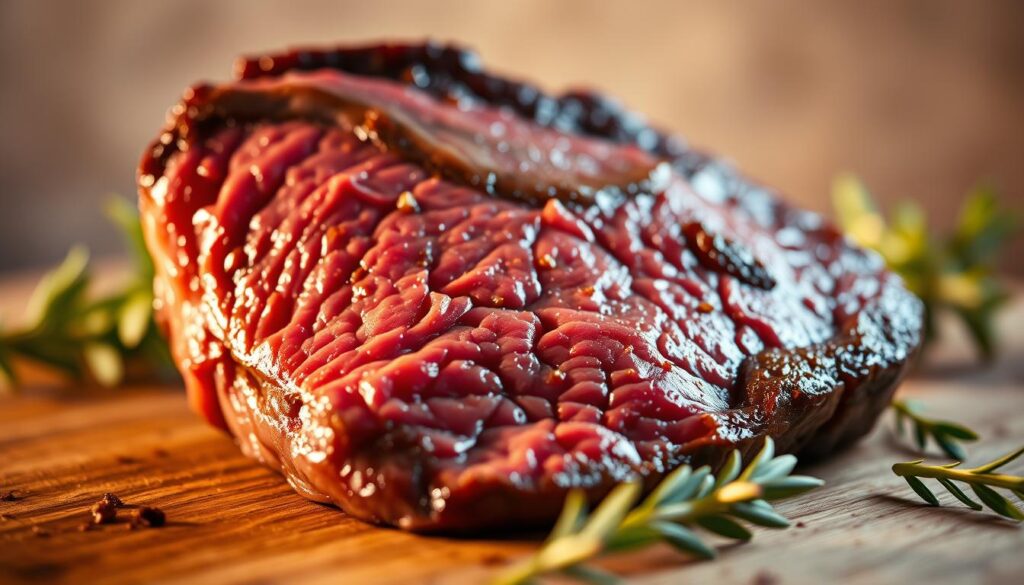
Eating skirt steak should be part of a balanced diet. Pair it with veggies and whole grains. Grass-fed beef may have more omega-3s and antioxidants.
Pairing Sides with Skirt Steak
Creating a memorable skirt steak meal means choosing the right sides and drinks. Think about what flavors and textures will make your meal better.
Recommended Vegetables
Vegetables add a fresh touch to your skirt steak meal. Try grilled asparagus, zucchini, or bell peppers to cook with the steak. Or, a salad with arugula or tomatoes can refresh your taste buds.
Brussels sprouts or carrots roasted can sweeten up your meal. Sautéed mushrooms also pair well, sharing umami with the beef.
Ideal Starches to Serve
Starches make a meal complete. Crispy roasted potatoes with herbs or creamy mashed potatoes are great. Polenta or grits add a creamy touch to bold steak flavors.
For a Latin twist, try Spanish-style rice. Or, a crusty bread can soak up the steak’s juices, making your meal even better.
Beverage Pairing Suggestions
The perfect drink can make your skirt steak dinner special. Bold red wines like Malbec, Cabernet Sauvignon, or Syrah match the meat’s taste. For beer lovers, craft beers such as amber ales or porters pair well with the steak’s caramelized outside.
For those who don’t drink alcohol, sparkling water with citrus, unsweetened iced tea, or fruit-forward mocktails are great. They help keep the steak’s flavors bright throughout your meal.
Cooking Skirt Steak for Different Occasions
Skirt steak is perfect for many meals, from family dinners to big celebrations. Knowing how do you cook skirt steak is essential to make it a hit at any event.
Casual Family Dinners
For quick weeknight meals, skirt steak is a great choice. A simple marinade in the morning can make it taste amazing. You can broil or pan-sear it fast. Try making fajitas or steak sandwiches for a crowd-pleaser.
Here are some tips for quick family dinners:
- Use a store-bought marinade or a mix of olive oil, lime juice, and spices
- Cook in a cast-iron skillet for a crispy crust
- Pair with pre-made sides like beans, rice, or roasted veggies
Grilling Parties
For grilling parties, plan ahead to cook for everyone. Set up a topping bar with different sauces. Grilling in batches or using multiple grills helps. Make sure all steaks rest before serving.
- Make a big marinade in a bowl or bag
- Use a meat thermometer for perfect doneness
- Let the steak rest before slicing thinly
Celebratory Dinners
For special events, skirt steak can be fancy. Use premium marinades like bourbon or aged balsamic. Fancy plating and sauces like red wine reductions or truffle butter can impress.
Here are ideas for fancy dinners:
- Pair with fancy sides like roasted root veggies or wild mushrooms
- Make a multi-course meal with skirt steak as the main dish
- Use top-quality ingredients for a memorable meal
Storing Leftover Skirt Steak
Proper storage of leftover skirt steak ensures you can enjoy it again without compromising on taste or safety. The process begins with cooling the cooked steak to room temperature within an hour to prevent bacterial growth, much like monitoring the skirt steak internal temp during cooking.
Cooling and Storage
To store leftover skirt steak, first, let it cool down to room temperature. This step is key to prevent bacterial growth. Once cooled, store it in airtight containers or wrap it tightly in plastic wrap and then in foil. For refrigeration, it’s best to consume the steak within 3-4 days.
If you plan to store it for a longer period, consider freezing. Slice the steak against the grain before freezing to make it easier to reheat only what you need. Wrap the sliced steak in airtight packaging or freezer bags, ensuring to remove as much air as possible to prevent freezer burn. Frozen skirt steak can maintain its quality for up to 2-3 months.
Reheating Leftover Skirt Steak
Reheating skirt steak requires care to prevent it from becoming tough or overcooked. One method is to bring the steak to room temperature before briefly searing it in a hot pan. Another method is using a sous vide machine for precise temperature control, ensuring the steak is heated evenly throughout.
Incorporating the leftover steak into sauces or dishes where it can warm up without direct heat exposure is another effective method. It’s generally advisable to avoid microwave reheating, as it can make the steak tough.
Creative Recipes for Leftover Skirt Steak
Leftover skirt steak can be repurposed into a variety of delicious dishes. Consider making a breakfast hash with diced potatoes and eggs, or a steak salad with a bold dressing. You can also add the pre-cooked steak to a quick stir-fry at the last minute, or use it in tacos with fresh toppings, or in hearty sandwiches with complementary spreads.
- Steak Salad: Toss sliced skirt steak with mixed greens, cherry tomatoes, and a citrus vinaigrette.
- Breakfast Hash: Dice the leftover steak and mix with roasted potatoes, onions, and scrambled eggs.
- Steak Tacos: Slice the steak thinly and serve in tacos with your favorite toppings.
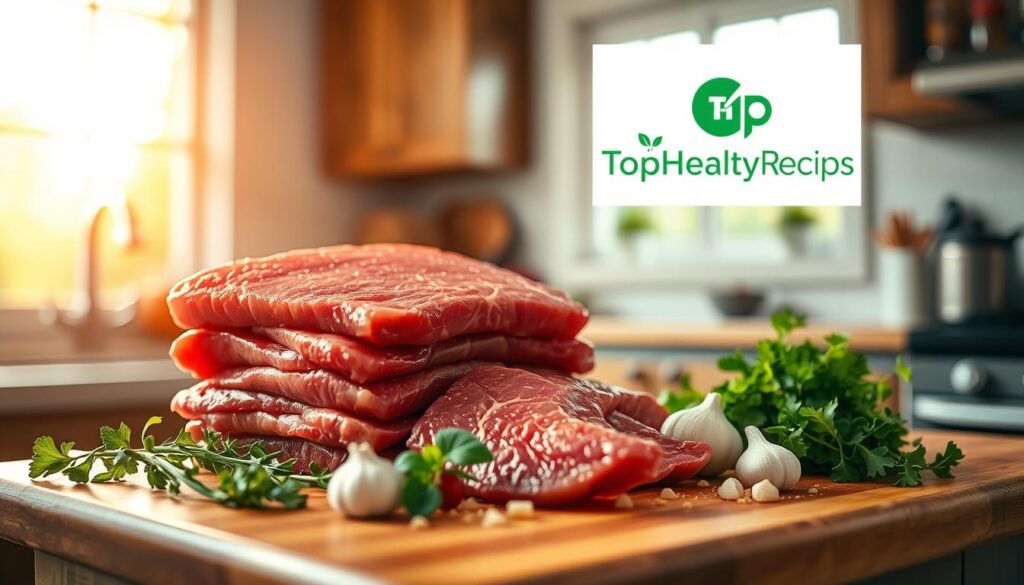
Skirt Steak Around the World
Skirt steak is loved by chefs all over the world. It’s used in everything from Latin American fajitas to Asian stir-fries. This cut is special because it works well with many flavors and cooking methods.
Latin American Flavors
Latin American food is known for its bold tastes and big dishes. Skirt steak is a star in many of these. In Tex-Mex, outside skirt steak is great for fajitas because of its strong taste.
In Argentina, churrasco uses inside skirt steak. This is because it grills evenly and consistently.
| Dish | Country | Preferred Skirt Steak Cut |
|---|---|---|
| Fajitas | Texas-Mexico | Outside |
| Churrasco | Argentina | Inside |
| Fraldinha | Brazil | Outside |
American BBQ Traditions
In the US, BBQ is all about different styles and cuts. Texas BBQ loves outside skirt steak for its smoky taste. On the West Coast, California’s Santa Maria-style BBQ uses inside skirt steak. This is because it grills well over red oak.
Skirt Steak in Asian Cuisine
Asian cooking is creative with skirt steak. In Korea, bulgogi uses thin inside skirt steak. Japan’s negimaki rolls also prefer inside skirt steak for its even thickness.
In China, stir-fries often choose outside skirt steak. This is because it has a strong flavor that pairs well with bold sauces.
FAQs About Cooking Skirt Steak
Whether you’re a seasoned grill master or a kitchen novice, cooking skirt steak to perfection is within your reach. This section addresses some of the most frequently asked questions about preparing this delicious cut of meat.
Cooking Time for Skirt Steak
Cooking skirt steak requires attention to timing and temperature. For medium-rare, cook the steak for 2-3 minutes per side at high heat, whether grilling or pan-searing. For medium, extend the cooking time to 3-4 minutes per side. It’s important to monitor the skirt steak internal temp instead of just timing. Aim for 130-135°F for medium-rare and 135-145°F for medium.
Slow Cooking Skirt Steak
While skirt steak can be cooked in a slow cooker, it’s not the most recommended method. Its lean and fibrous nature can make it stringy with prolonged cooking. If you want to try slow cooking, limit it to 2-3 hours on low. Slice the steak very thinly against the grain before serving. Consider adding it to saucy dishes to make it less tough.
Best Cut for Fajitas
Traditionally, outside skirt steak was the preferred choice for authentic fajitas due to its intense flavor. Inside skirt steak is more commonly found in supermarkets and yields excellent results with proper preparation. It’s a great alternative. The key is to cook it correctly and slice it against the grain.
Additional Tips
Other common questions include whether to remove the membrane (yes, if it’s tough) and if skirt steak can be cooked sous vide (yes, with excellent results at 129-134°F for 2-4 hours). To handle the uneven thickness of the cut, consider butterflying thicker sections or positioning thinner parts further from direct heat.
Final Thoughts on Cooking Skirt Steak
Cooking skirt steak to perfection is a skill you can learn. It takes practice and patience. The secret to juicy, tender steak is knowing the difference between inside and outside skirt steak. Also, using high-heat cooking and checking internal temperatures is key.
Key Takeaways
To sum up, cutting against the grain and using a meat thermometer are important. Letting the steak rest is also a must. These steps work for both inside and outside skirt steak, leading to tasty results.
Experimenting with Flavor
Now, you know the basics of cooking skirt steak. It’s time to get creative. Try different marinades, seasonings, and cooking methods to make your own skirt steak recipe. Explore international flavors to add a unique twist to your dishes.
Sharing Your Experience
As you improve your skirt steak cooking, share your journey. Document your successes and what you’ve learned. Share your favorite recipes and tips with others. This way, you can build a community around this beloved dish.
FAQ
How Long to Cook Skirt Steak?
Can You Cook Skirt Steak in a Slow Cooker?
What’s the Best Cut for Fajitas?
How Do You Cook Skirt Steak?
What is Skirt Meat?
Inside vs Outside Skirt Steak: What’s the Difference?
How to Make Skirt Steak Tender?
What’s the Ideal Internal Temperature for Skirt Steak?
For more cooking tips, stay connected with us. We also recommend the cookbook Skinnytaste Simple: Easy, Healthy Recipes with 7 Ingredients or Fewer
For more Recipes about Steak ?
Did You try our recipe ?
There are no reviews yet. Be the first one to write one.
